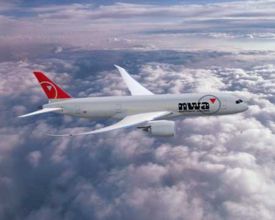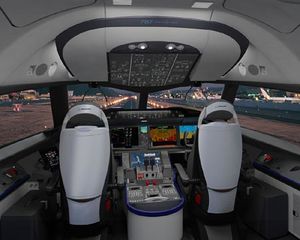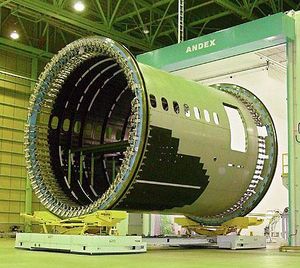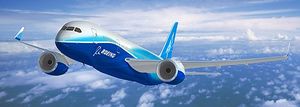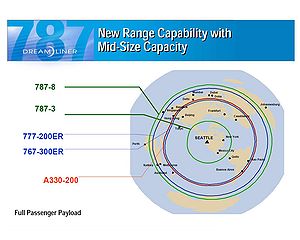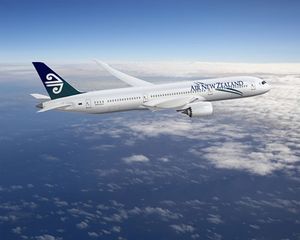PlaneSpottingWorld welcomes all new members! Please gives your ideas at the Terminal.
Boeing 787
| 787 Dreamliner | |
|---|---|
| Rendering of the Boeing 787-8 final design, in Northwest Airlines livery | |
| Type | Wide-body jet airliner |
| Manufacturer | Boeing Commercial Airplanes |
| Status | Under development |
| Number built | 0 as of 2007 |
| Unit cost | 787-3: US$138-143 million 787-8: US$148-158 million 787-9: US$179-188 million |
The Boeing 787 Dreamliner is a mid-sized, wide body, twin engined jet airliner currently under development by Boeing's Commercial Airplanes unit and scheduled to enter service in May 2008.[1][2] It will carry between 210 and 330 passengers depending on the seating configuration, and will be more fuel-efficient than comparable earlier airliners. It will also be the first major airliner to use composite material for most of its construction.[3]
Prior to January 28, 2005, the 787 was known as the developmental designator 7E7. The early renderings released depicted a radical design with highly curved surfaces. On April 26, 2005, one year to the day after the launch of the program, the final look of the external 787 design was frozen with a less rakish nose and a more conventional tail.
Contents
Background
In the late 1990s, Boeing began to consider a replacement for the 767 when sales weakened from the competing Airbus A330-200. As sales of the Boeing 747-400 were also slowing, the company proposed two new aircraft — the Sonic Cruiser and the 747X. The Sonic Cruiser would have achieved higher speeds (approximately Mach 0.98) while burning fuel at the same rate as the existing 767 or A330. The 747X, competing with the Airbus A380, would have stretched the 747-400 and improved efficiency by using a composite supercritical wing.
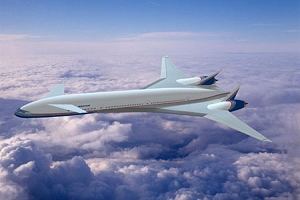
Market interest for the 747X was tepid; the Sonic Cruiser had brighter prospects. Several major airlines in the United States, including Continental Airlines, voiced their optimism for the concept.[citation needed] By decreasing travel time, they would be able to increase customer satisfaction and aircraft utilization.
The September 11, 2001 attacks upended the global airline market. Airlines were unable to justify large capital expenditures, and due to increased petroleum prices, became more interested in efficiency than speed. The worst-affected airlines, in the United States, were considered the most likely customers of the Sonic Cruiser. Boeing offered airlines the option of using the airframe for either higher speed or increased efficiency, but the high projected airframe costs caused demand to evaporate further. Boeing canceled the 747X once Airbus launched production of the Airbus A380, and switched tracks by offering an alternative product, the 7E7.[3]
On April 26, 2004, the Japanese airline All Nippon Airways (ANA) became the launch customer for the 787, then still known as the 7E7, by announcing a firm order for 50 aircraft to be delivered beginning in April 2008. ANA's order included thirty 787-3, 290-330 seat, one-class domestic aircraft, and twenty 787-8, long-haul, 210-250 seat, two-class aircraft for regional international routes such as Tokyo Narita-Beijing. The aircraft will allow ANA to open new routes to mid-sized cities not previously served, such as Denver or Montreal. As is common for launch customers in the aviation industry, ANA is rumored to have received a discount of 40-50% off the official list price.
Customer-announced orders and commitments for the 787 reached 237 aircraft during the first year of sales, and numbered 468 at the end of February, 2007. Boeing expects to have 500 firm orders by entry into service (EIS). This would make the 787 the fastest-ever selling wide-bodied airliner upon EIS.[4][5]
The 787-3 and 787-8 variants will be available first, while the 787-9 will enter service in 2010, despite industry rumors that it would be delayed as orders for the 787-3 and 787-8 sold out early production. By the end of 2006, eight customers had ordered a total of 77 787-9s.
Boeing initially priced the 787-8 variant at US$ 120 million, a low figure which surprised the industry. Its price has been increased twice since launch. As of 2007, the list price was US$ 138-143 million for the 787-3, US$ 148-157.5 million for the 787-8, and US$ 178.5-188 million for the 787-9.[6]
Development
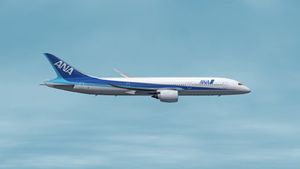
The replacement for the Sonic Cruiser project was dubbed the 7E7 (with a development code name of Y2.) The "E" was said to stand for various things, depending upon the audience. To some, it stood for "efficiency", to others it stood for "environmentally friendly", etc. In the end, Boeing claimed it merely stood for "Eight", after the aircraft was eventually rechristened "787".[3]
The 787 essentially uses the technology proposed for the Sonic Cruiser in a more conventional airframe configuration (see Features). Boeing claims that the 787 will be up to 20% more fuel-efficient than current comparable aircraft. Roughly one-third of this efficiency improvement will come from the engines; another third from aerodynamic improvements and the increased use of lighter weight composite materials; and the other third from advanced systems. The most notable system advancement contributing to efficiency is a "more electric architecture" which replaces bleed air and hydraulic power with electrically powered compressors and pumps. Technology from the Sonic Cruiser and 787 will be used as part of Boeing's project to replace its entire airliner product line, called the Yellowstone Project (of which the 787 is the first stage).
Boeing selected two engine types, the General Electric GEnx and Rolls-Royce Trent 1000 to power the 787, both placed in pods under the wing. Significantly, this leaves Pratt & Whitney, which normally has an entrant in this market space, unable to offer one of its own engines to 787 customers. According to UTC CEO George David, Pratt & Whitney "couldn't make the business case work for that engine."[7] Also, according to industry sources, Boeing may have wished to rely on evolved versions of existing engines rather than the higher-risk option of an all new engine from Pratt & Whitney. For the first time in commercial aviation, both engine types will have a standard interface with the aircraft, allowing any 787 to be fitted with either a GE or Rolls-Royce engine at any time. Engine interchangeability makes the 787 a more flexible asset to airlines, allowing them to change from one manufacturer's engine to the other's in light of any future engine developments which conform more closely to their operating profile.[3] The engine market for the 787 is estimated at US$40 billion over the next 25 years. The launch engine for all 3 current 787 variants is the Rolls-Royce Trent 1000.
The launch of a new airliner can be expected to draw scathing comments from competitors, Boeing's doubt over the Airbus A380 and Airbus' mocking of the Sonic Cruiser being recent examples. The 787 is no exception, as Airbus' John Leahy has made attempts at refuting all of Boeing's claims, openly criticizing the large-scale use of composites in the 787's fuselage as being "rushed and ridiculous", although Boeing built and tested the first composite section while examining the Sonic Cruiser concept nearly five years ago,[8] making the 787 a significantly refined product.[9] Airbus has offered the competing A350 using derivatives of the turbofans developed for the 787. This new jet will make less widespread use of composites with Airbus preferring aluminum-lithium alloys for the fuselage.[10]
In order to compete with the A350-900, and especially to compete for the large order from Emirates and an order from British Airways, Boeing has announced it might produce a "787-10", with seating capacity between 290 - 310.[11][12] Production of this new model is projected for 2012. Formal launch may come in 2007.[13]
This proposed stretched variant is intended to compete with the planned Airbus A350-900.[14] The 787-10 would supersede the 777-200ER in Boeing’s current lineup, and could also be targeted to replace the Airbus A330-300 and A340-300, and McDonnell Douglas MD-11. Emirates Airlines and Qantas have shown interest in such variant which would enter service in 2012.[15] This variant has not yet been officially launched by Boeing, but Mike Bair, head of the 787 Program, has already stated that “It's not a matter of if, but when we are going to do it... The 787-10 will be a stretched version of the 787-9 and sacrifice some range to add extra seat and cargo capacity.”[16] However, while Boeing is optimizing the 787-9, many aerodynamic improvements may be found on the 787-10 [If version is to be launched]. If it is a requirement, Boeing will request a more powerful engine with higher thrust ratings.
Description
Features
- 18.5 in (47 cm) seat-bottom width (depending on aisle armrest widths) in 2+4+2 or 3+2+3 arrangements. Seat widths would be approximately 17.2 in (43.7 cm) for 3+3+3 seating.
- Cabin interior width 50 in (127 cm) from the floor is 18 ft 7 in (566 cm) and was recently increased by 1 inch (2.5cm). The 787's interior cabin width, measured at seated eye level (where width is, according to Boeing studies, actually perceived) is a full 15 in (38 cm) greater than that of the Airbus A330 and A340, but 5 in (13 cm) smaller than the currently expected future competitor, the A350-800 XWB. Two class configuration of 240 seats in two class domestic with 46 in (116.8 cm) first class pitch and 34 in (86.4 cm) coach class. 296 passengers can be seated in a high density 3+2+3 coach arrangement with 36 in (91.4 cm) Business and 32 in (81.3 cm) Coach pitch. Up to 234 passengers may be seated in a three-class setup that uses 61 in (154.9 cm) pitch in First Class (2+2+2 or 2+1+2), 39 in (99 cm) pitch for Business (2+3+2 or 2+2+2) and 32 in (81.3 cm) for Coach (2+4+2).
- Cruise speed: 0.85 Mach (903 km/h or 561 mph at altitude)
- Range of 8,000 to 8,500 nautical miles (14,800 to 15,700 km), enough to cover the Los Angeles to Bangkok or New York City to Taipei routes.
- Construction materials (by weight): 50% composite, 20% aluminum, 15% titanium, 10% steel, 5% other. Composite materials are significantly lighter and stronger than traditional aircraft materials, making the 787 a very light aircraft for its capabilities. By volume, the 787 will be 80% composite. This will allow the potential to take off from, and land on, relatively short airstrips as the 767 can, yet still have the capability to fly long-haul distances.[17]
- The 787 production line will be able to finish an aircraft in as little as three days, compared to 11 days for the 737.
- Larger windows than any other current in service civil air transport (27 cm by 47 cm), with a higher eye level, so passengers can see the horizon, with liquid crystal display (LCD)-based "auto-dimming" to reduce cabin glare and maintain transparency. These are to be supplied by PPG[18]
- Light-emitting diode (LED) cabin lighting (three color) will be used instead of fluorescent tubes, allowing the aircraft to be entirely 'bulbless' and have 128 color combinations.
- A version of Ethernet – Avionics Full-Duplex Switched Ethernet (AFDX) / ARINC 664 -- will be used to transmit data between the flight deck and aircraft systems.
- LCD multi-function displays on the flight deck, all of which will use an industry standard GUI widget toolkit (Cockpit Display System Interfaces to User Systems / ARINC 661)[19]
- Bleedless turbofans, allowing elimination of superheated air conduits normally used for de-icing, aircraft power, and other functions. These systems are to be replaced with an all-electrical system.[3]
- Cabin air provided by electrically driven compressors (no engine bleed air).
- Higher humidity in the passenger cabin because of the use of composites (which do not corrode).
- The internal pressure will be increased, to the equivalent of 6000 feet (1800 m) altitude versus 8000 feet (2400 m) on conventional aircraft. This will significantly improve passenger comfort.{cn}
- Boeing is experimenting with several engine noise reducing technologies for the 787. Among these are a redesigned air inlet containing sound-absorbing materials and redesigned exhaust duct covers whose rims are tipped in a toothed pattern to allow for quieter mixing of exhaust and outside air. Boeing expects these developments to make the 787 significantly quieter both inside and outside the passenger cabin.
- Improved ride quality through Active Gust Alleviation system, similar to that Boeing built for the B-2 bomber.
Early concept images of the 787 included rakish cockpit windows, a dropped nose, and a distinctive "shark-fin" vertical stabilizer. The final styling of the aircraft was more conservative, with the fin less radical than on earlier images, but the nose and cockpit windows were retained.
Production
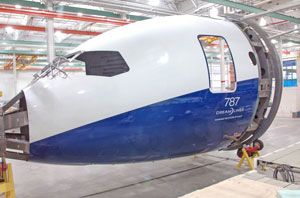
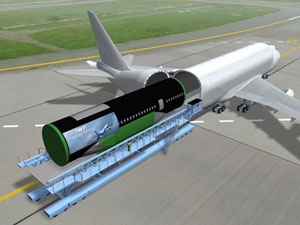
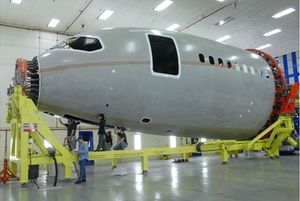
Boeing will manufacture the 787's tail fin at its plant in Frederickson, Washington, ailerons and flaps at Boeing Australia, and fairings at Boeing Canada. For its entire history, Boeing has jealously guarded its techniques for designing and mass producing commercial jetliner wings. Due to economic and political reasons, the wings will be manufactured by Japanese companies in Nagoya, e.g. Mitsubishi Heavy Industries, while the horizontal stabilizers will be manufactured by Alenia Aeronautica in Italy, and the fuselage sections by Vought in South Carolina (USA), Alenia in Italy, Kawasaki Heavy Industries in Japan, and Spirit AeroSystems, in Wichita, Kansas (USA).[20]
The passenger doors will be made by Latecoere (France) while the cargo doors, access doors and crew escape door will be made by Saab (Sweden). Japanese industrial participation is very important to the project, with 35% workshare, with many of the subcontractors supported and funded by the Japanese government. [1] On April 26 2006, Japanese manufacturer Toray Industries and Boeing announced a production agreement involving $6 billion worth of carbon fiber. The deal is an extension of a contract signed in 2004 between the two companies and eases some concerns that Boeing might have difficulty maintaining its production goals for the 787.[3]
From France, Messier-Dowty will build the landing gear and Thales will supply the integrated standby flight display, electrical power conversion system, and in-flight entertainment.[3]
Honeywell and Rockwell-Collins will provide flight control, guidance and other avionics systems, including standard dual head up guidance systems. Future integration of forward looking infrared is being looked at by Flight Dynamics allowing improved visibility using thermal sensing as part of the HUD system, allowing pilots to "see" through the clouds.[3]
Hamilton Sundstrand will provide power distribution and management systems to the aircraft, including manufacture and production of Generator Control Units (GCUs) as well as integration of power transfer systems that can move power from the Auxiliary Power Unit (APU) and the main engines to the necessary parts and machinery of the aircraft.
The final assembly will consist of attaching fully-completed subassemblies,[21] instead of building the complete aircraft from the ground up. This is a technique which Boeing has previously used on the 737 program, which involves shipping fuselage barrel sections by rail from Spirit's Wichita, Kansas facility to Boeing's narrowbody final assembly plant at Renton, Washington. Airbus has also used this technique in the past, although in its case it is more of a political necessity resulting from partner nations' divided workshare. After stiff competition, Boeing announced on December 16, 2003 that assembly would take place in Everett, Washington, employing 800 to 1,200 people.[3]
The 787 will undergo wind-tunnel testing at Boeing's Transonic Wind Tunnel, QinetiQ's five-meter wind tunnel based in Farnborough, UK, and NASA Ames Research Center's wind tunnel, as well as at the French aerodynamics research agency, ONERA.
The first composite section rolled out in January 2005, and final external design was set in April 2005. On June 30, 2006 Boeing celebrated the start of major assembly of the first 787 at Fuji Heavy Industries' new factory in Handa, Japan, near Nagoya.[22]
Boeing intends to deliver 118 aircraft during the first 18 months of production. Due to customer demand, Boeing is currently considering whether to open a second production line, if the production capacity of suppliers allows.[13] For example, Alenia is said to be able to produce only seven 787 fuselage sections per month.[citation needed] Boeing's past difficulties with increased production rates resulted in severe delivery delays in 1999.[13]
On December 3, 2006, Boeing conducted a "virtual rollout" of the 787. Unlike a traditional rollout (which will occur later), it took place without a physical airframe present. Taking computer aided design beyond the aircraft itself, Boeing modeled the manufacturing process, step-by-step and end-to-end, in software. The virtual rollout is intended to discover production issues prior to assembly of the first airframe, when they are cheaper to fix.[23]
On January 12, 2007, first major assemblies, forward fuselage, center wing and center wheel well built by FHI and KHI were shipped on 747-400 LCF from Nagoya, Japan. They were delivered to Global Aeronautica in Charleston, South Carolina on January 15, 2007. [24]
On February 15, 2007, the first production nose section (Section 41) was unveiled at Spirit AeroSystems in Wichita, Kansas. This was the first production nose section, used in the first complete flight-test 787 and represents those used in all subsequent production 787s. It encompasses the cockpit area, nose landing gear well and the forward-most section of the passenger area. The section is oval-shaped (as is the entire fuselage) and is 21 feet (6.4 m) in height, 19 feet (5.74 m) in width and 42 feet (12.8 m) in length. 787 parts made by Spirit AeroSystems are shipped directly to Boeing's final assembly plant in Everett, Washington via 747 LCF.
Technical concerns
Engine interchangeability
The two types of engines compatible with the 787 will use a standard electrical interface, potentially allowing any aircraft to be fitted with Rolls-Royce or GE engines at any time. This flexibility will allow an airline to switch from one manufacturer to the other in the event of technological developments which conform more closely to their operating profile. Boeing's goal is to make changing engine types as simple as a standard same-manufacturer replacement.
According to ILFC's Vice President of Marketing, Marty Olson, changing engine types on a 787 could take as long as 15 days and so be economically unfeasible. "You'd have to take all the pylon, everything from the wing down, off" Olson said. He went on to complain that Boeing is still promoting the 24 hours change in spite of promises to alter their marketing. Current aircraft can have engines changed to those of a different manufacturer but this rarely happens due to the costs involved. Boeing's response is that the design is not yet finalized and 24 hours remains their goal.[25]
Composite fuselage
It was suggested by many that the risks of having a composite fuselage have not been fully assessed and should not be attempted. It was also added that carbon fiber, unlike metal, does not visibly show cracks and fatigue and repairing any damage done to the aircraft would not be easy.[26] Boeing has dismissed such notions insisting that composites have been used on wings and other passenger aircraft parts for years and this is a non-issue. They have also stated that special defect-detection procedures will be put in place to negate any concern.[27] In 2006 Boeing launched the 787 GoldCare program. This is a comprehensive life-cycle management service whereby all the aircraft that sign up for this program are routinely monitored and repaired if needed. This is the first program of its kind from Boeing. After sale protection programs are not new but have usually been offered by third party service centers. Boeing believes this brings them additional revenue and will also allow them to nullify any concern over maintaining this aircraft for overanxious airlines.
Weight Issues
The 787 has been troubled by excess weight since assembly of the first unit began earlier in 2006. This is typical in aviation for new aircraft during their development phase. The aircraft is first designed on computers and an empty weight is promised to customers to ensure fuel efficiency and payload obligations. However upon assembly, some parts may be manufactured with minor variances that multiply dramatically if the part is used frequently.
The first six 787s built will be overweight according to Boeing Commercial Airplanes CEO Scott Carson, but the seventh is expected to be on target.[28] Boeing has redesigned some parts, and made more use of titanium.[23] The weight target that is pledged to customers is for a "green aircraft" with no interior fittings. Each airline chooses its own seats, and amenities which add weight in varying degrees, but are not related to Boeing's obligations.
Although aircraft of a new type like the 787 are often overweight, peformance guarantees to customers can still be met by increasing performance in other areas of the design. Boeing assured customers that the 787 would be well within performance guarantees and historically has delivered better performance than promised.
Variants
There are three variants of the 787 and all launched at the same time in 2004. The 787-8 will enter service in 2008. The 787-3 will enter service next in 2010. The last to enter service will be the 787-9 in 2010.
787-3
This will be a 223 seat (three class) or 296 seat (two class) short-range version targeted at high-density flights, with a range of 2,500 to 3,050 nautical miles (4,650 to 5,650 km) when fully loaded. It is designed to replace the Airbus A300, Boeing 757-300, Boeing 767-200 and -300. The 787-3's intended entry into service is 2010. This model is limited in its range, not by fuel capacity but by a low maximum take-off weight of 360,000 lb (163,290 kg). It currently has the same fuel capacity as the 787-8. Range is given for any fuel capacity left after the aircraft weight and payload is subtracted from the Maximum Take-Off Weight (MTOW). With a full load of passengers and cargo, it will be limited in the amount of fuel it can take on board. This is an advantage on shorter, high-density routes especially those separated by water such as Tokyo to Shanghai, Osaka to Seoul or London to Berlin. Many airports charge landing fees depending on the weight of the aircraft, thus an airliner rated at a lower MTOW would pay lower fees.
The 787-3's wing will be different from the other versions, with the raked wingtips that improve long-range efficiency removed and winglets added. This decreases the wingspan and the aircraft weight. The wing will be the same except for the last 13 feet[29] outboard of the ailerons. Winglets provide better efficiency over short distances while raked wingtips are superior over long distances.[citation needed]
Thirty years ago it was common to fly from New York to Los Angeles in a 747. Typically four or five flights occurred per day, one per major airline. With deregulation, more and more airlines joined the route. Overcapacity led to airlines using smaller planes. Now there are around 47 direct flights per day mostly on 737 or Airbus A320 or reconfigured 757s and 767-200s between the two cities, with each flight usually carrying around 100-160 passengers (70% load factor). This has led to higher congestion and more pollution. This same phenomenon is occurring in Asia, Europe, and South America. With the proliferation of open sky agreements, numerous airlines have been started in countries like Brazil, India, China, and throughout Europe. These start ups have placed more pressure on capacity on trunk routes and have encouraged the usage of ever smaller planes between very large cities. Routes like São Paulo to Buenos Aires, Berlin to Paris, Mumbai to Calcutta are now increasingly being served by single aisle planes when larger ones would be more logical. Boeing believes that the pendulum has swung too far and the future of aviation between very large (but close) cities of five million or more would stabilize around the capacity level of the 787-3. It also believes legacy carriers that want to battle with low cost airlines can use this plane with twice the capacity of a single aisle craft but less than twice its operating cost (fuel, landing fees, maintenance, number of flight crew, airspace fees, parking fees, gate fees, etc.). Boeing sees the 787 family as a game changer with this variant as the most unique of the three.[2]
Regions such as India and East Asia, where large population centers are in close proximity, can make good use of the 787-3. Roughly 3.1 billion people live within the range of the 787-3 if used in India or China. The 787-3's efficiency may offset the higher landing fees and acquisition costs (compared to a single-aisle plane) and make it useful on such routes. A 3,050 nm (5,600 km) range, or flight time of roughly six hours, is sufficient to connect many major cities and improve comfort and efficiency. The 787-3 is not a replacement for single aisle planes, but can relegate them to cities with fewer than 2 million people.
To date, however, only Japanese airlines have ordered this model for routes within East Asia.
787-8
This variant is similar to the -3 except has longer wings with raked wing tips.[29] The -8 has a range of 7,650 to 8,200 nautical miles (14,200 to 15,200 km) and seats 223 passengers in three classes. Entry into service is planned in 2008. Boeing is targeting the 787-8 to replace the 767-200ER and 767-300ER.
787-9
This will be a stretched variant seating 263 in three classes with a range of 8,000 to 8,500 nautical miles (14,800 to 15,750 km). The targeted EIS is set at 2010.[30] Boeing is targeting the 787-9 compete with the Airbus A330-200 and A340-200, and replace Boeing 767-400ER, and McDonnell Douglas DC-10. This model is very similar to the 787-8 except for structural strengthening and the stretched fuselage. When first introduced, it had the same fuel capacity as the other two models. This gave it a slightly shorter range than the -8. Upon further consultation with airlines and design changes, it incorporated one extra forward tank to increase its fuel capacity. It will have the lowest seat-mile cost of any 787. It will have a longer range and a higher MTOW than the other two initial variants. It can fly non-stop from New York to Manila or from Moscow to São Paulo.
Air New Zealand is the launch customer of this variant with 8 orders to date. Sales of this variant have been limited by its 2010 entry into service rather than any shortcomings. The smaller size and the entry date of the 787-8 being two years earlier was a great enticement for most airlines and led to the -8 taking most orders. Now with the first two years of production completely sold out, airlines have been weighing the option of the 787-8 against the 787-9 since either one can be delivered after 2010. Qantas and Singapore Airlines have placed the largest orders for this variant.
Specifications
| Model | 787-3 | 787-8 | 787-9 |
|---|---|---|---|
| Cockpit crew | Two | ||
| Passengers | 223 (3-class) 296 (2-class) |
223 (3-class) | 263 (3-class) |
| Length | 186 ft 1 in (56.72 m) | 206 ft (63 m) | |
| Wingspan | 170 ft (52 m) | 197 ft 3 in (60.12 m) | |
| Wing Sweepback | 32.2° | ||
| Height | 55 ft 6 in (16.92 m) | ||
| Cabin width | 18 ft 9in (5.77 m) | ||
| Max. take-off weight | 360,000 lb (163,636 kg) |
480,000 lb (217,724 kg) |
540,000 lb (244,940 kg) |
| Cruise speed | .85 Mach | ||
| Range, loaded | 2,500 - 3050 nm (4,650 - 5,650 km) |
7,650 - 8,200 nm (14,200 - 15,200 km) |
8,000 - 8,500 nm (14,800 - 15,750 km) |
| Max. fuel | 33,528 US gal (126,903 L) | 33,528 US gal (126,903 L) | 36,693 US gal (138,700 L) |
| Service ceiling | 43,000 ft (13,100 m) | ||
| Engines (2×) | General Electric GEnx or Rolls-Royce Trent 1000 | ||
Orders and deliveries
This plane has not yet entered service. To see all current orders please see the list of Boeing 787 orders.
Trivia
- The all-composite fuselage makes the 787 the first twin-aisle composite airliner in production.
- At Mach 0.85, the 787 will be among the fastest commercial airplanes from Boeing.
- The Lockheed Martin Orion spacecraft will use a glass cockpit derived from Honeywell's 787 flight deck.[31]
References
- ↑ "ANA rules out swapping delivery slots for 787." Reuters. November 12, 2006.
- ↑ "787's big sections may be in Everett by February." Wallace, J. Seattle Post-Intelligencer. November 7, 2006.
- ↑ 3.0 3.1 3.2 3.3 3.4 3.5 3.6 3.7 3.8 Norris, G.; Thomas, G.; Wagner, M. and Forbes Smith, C. (2005). Boeing 787 Dreamliner - Flying Redefined. Aerospace Technical Publications International. ISBN 0-9752341-2-9.
- ↑ "Boeing/McDonnell Douglas Orders and Deliveries." Boeing.
- ↑ " Corporate Information - Orders and Deliveries." EADS Airbus.
- ↑ "Commercial airplane - jet prices." Boeing.
- ↑ "Rolls-Royce At Your Service." BusinessWeek. November 14, 2006.
- ↑ "Boeing Testing Sample Sonic Cruiser Fuselage." Boeing.
- ↑ "Development Work on Boeing 787 Noses Ahead." Boeing. July 13, 2005.
- ↑ "The A350 XWB: a family concept with all of the extras." EADS Airbus.
- ↑ "Everett work force for 787 pegged at 1,000." Wallace, J. Seattle Post-Intelligencer. December 22, 2005.
- ↑ Thomas, G.. "Boeing looks at larger Dreamliner to meet Emirates, BA requirements", Air Transport World, ATW Media Group, 2005-09-26.
- ↑ 13.0 13.1 13.2 "Boeing Considers Second Assembly Line For 787 Dreamliner." Pearson, D. The Wall Street Journal. April 27, 2006.
- ↑ Thomas, G.. "Boeing bullish on 787-10, Dreamliner production", Air Transport World, ATW Media Group, 2005-12-23.
- ↑ Baseler, Randy. Dash 10. Boeing Blog. Retrieved on 2006-02-08.
- ↑ "Boeing to Build Stretch 787 Jet," The Wall Street Journal, March 27, 2006.
- ↑ "$76 million extreme makeover for Wellington Airport." Wellington International Airport press release. August 4, 2005.
- ↑ "Qantas deal sees launch of 787-9." Norris, G. Flight International. December 20, 2005.
- ↑ "What is ARINC 661?" Web archive of Engenuity Technologes page.
- ↑ "Boeing 787: Parts from around world will be swiftly integrated". Gates, D. The Seattle Times, September 11, 2005.
- ↑ "Boeing Unveils 787 Final Assembly Factory Flow." Boeing. December 6, 2006.
- ↑ "Major Assembly of First Boeing 787 Dreamliner Starts." Boeing press release. June 30, 2006.
- ↑ 23.0 23.1 "Virtual rollout of the 787." Wallace, J. Seattle Post-Intelligencer. December 7, 2006.
- ↑ "Boeing Closer To Delivering 787." Boeing press release. January 12, 2007.
- ↑ "787 Isn't Meeting 24hour-Engine Change Promo, lessor says." Leeham Co. LLC. July 18, 2005.
- ↑ "The 787 Encounters Turbulence." BusinessWeek. June 19, 2006.
- ↑ "Airbus to use composites." Wallace, J. Seattle Post-Intelligencer. January 10, 2006.
- ↑ Boeing Still Working On 787 Weight Issue, Carson Says." Associated Press. December 7, 2006
- ↑ 29.0 29.1 "The Boeing 787 Dreamliner: More Than Just an Airplane." Nielson, D. Boeing. May 17, 2005.
- ↑ "Aerospace Notebook: New 787 is taking off." Wallace, J. Seattle Post-Intelligencer. April 27, 2005.
- ↑ Coppinger, Rob. "NASA Orion crew vehicle will use voice controls in Boeing 787-style Honeywell smart cockpit", Flight International, October 6, 2006. Retrieved on 2006-10-06.
External links
- 787 Facts (from BCA)
- 787 Customer list (from BCA)
- Boeing 787 Airport Compatibility brochure (from BCA)
- BCA order sheet for the 787, does not include announced but unsigned contracts.
- 787 videos.
- Boeing 787 Dreamliner Official Homepage (from Boeing)
- Boeing 787 photos (from BCA)
- A detailed analysis of the 7e7's business affairs
- Boeing 787 page at Aircraft-Info.net
- Archived ANA info page on 787
- 787 and WTO
- 787 page on Aerospace-Technology.com
- Video of 787 composite tape laying, The Chicago Tribune.
- 787 program suppliers at Airframer.com
Related content
Related development
Comparable aircraft
Related lists
See also
Boeing airliners | |
|---|---|
| Piston-engined | |
| Jet-engined | |
| In development | |
| Proposed | |
| Not developed | 2707 · 7J7 · NLA · Sonic Cruiser |
Lists relating to aviation | |
|---|---|
| General | Timeline of aviation · Aircraft · Aircraft manufacturers · Aircraft engines · Aircraft engine manufacturers · Airports · Airlines |
| Military | Air forces · Aircraft weapons · Missiles · Unmanned aerial vehicles (UAVs) · Experimental aircraft |
| Notable incidents and accidents | Military aviation · Airliners · General aviation · Famous aviation-related deaths |
| Records | Flight airspeed record · Flight distance record · Flight altitude record · Flight endurance record · Most produced aircraft |
